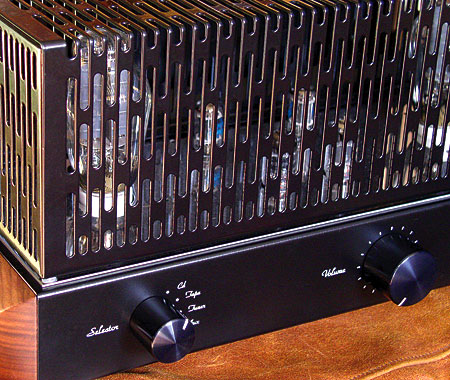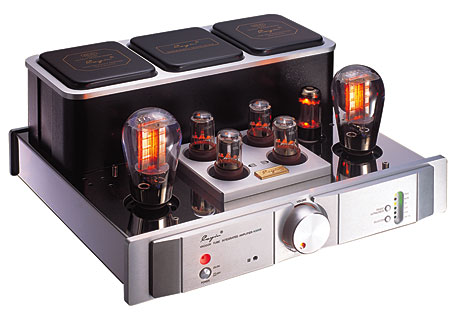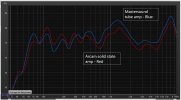I have both a tube amp (Mastersound SET 300b) and a solid state amp (Arcam A32), with Klipsch Forte 4 speakers. The Mastersound sounds much better; more clear, very lifelike. But when I measure with REW the frequency response and THD are about the same (with some small differences in harmonic content, about half a percent). Is there any other measurement parameter that causes one amp to sound better than the other? Is what I hear not truly reflected by the measurements?
-
WANTED: Happy members who like to discuss audio and other topics related to our interest. Desire to learn and share knowledge of science required. There are many reviews of audio hardware and expert members to help answer your questions. Click here to have your audio equipment measured for free!
- Forums
- Audio, Audio, Audio!
- Amplifiers, Phono preamp, and Analog Audio Review
- Stereo and Multichannel Amplifier Reviews
You are using an out of date browser. It may not display this or other websites correctly.
You should upgrade or use an alternative browser.
You should upgrade or use an alternative browser.
Tube vs solid state amp measured with REW
- Thread starter Ken57
- Start date
Keith_W
Major Contributor
What are you measuring? The output from the amp? The output from the speaker? And also, what level are you measuring at? Enough to clip the amp?
A pet theory of mine is that SET amps "help" horns by limiting peaks, basically soft clipping. Horns are capable of dynamic peaks that most cone drivers can't touch, and on some music that may become hard on the ears.
- Thread Starter
- #4
I'm measuring with a calibrated microphone in front of the speaker, at regular listening levels (probably not clipping).What are you measuring? The output from the amp? The output from the speaker? And also, what level are you measuring at? Enough to clip the amp?
- Joined
- Feb 23, 2016
- Messages
- 20,771
- Likes
- 37,636
The Forte 4 has a pretty up and down uneven impedance curve vs frequency. I would expect the output impedance of the SET to alter the frequency response enough to make it sound slightly different. I would think your REW FR plots would show this. Even a couple tenths of a db over an octave or two is audible. Won't look like much on the graph unless you zoom in. So about the same FR could well not sound the same. Some smoothing to get a handle on what your ear hears might help too. I might try pyschoacoustic smoothing or 1/6th octave smoothing. Your ear is closer to 1/3rd octave smoothing at lower frequencies and 1/5th or so at the higher range.
Keith_W
Major Contributor
Try measuring at different levels and see if the FR and harmonic content changes.
- Joined
- Feb 23, 2016
- Messages
- 20,771
- Likes
- 37,636
This is from Stereophile's testing of your Mastersound. This variation is enough to be audible. Your speaker probably has wider impedance variations than the Stereophile loudspeaker simulated load. This will cause even larger FR differences than Stereophile is showing.

 www.stereophile.com
www.stereophile.com


Mastersound 300 B S.E. integrated amplifier Measurements
Sidebar 3: Measurements
- Thread Starter
- #8
Yes, I'm seeing these sorts of variations. I'm using a software equalizer to flatten this out. There is also a lot of room variations.
I'm seeing a few tenths percent increase in 2nd order harmonics, and a few tenths reduction in third order harmonics, compared to the solid state amp. Is that significant? Or not audible?
I'm seeing a few tenths percent increase in 2nd order harmonics, and a few tenths reduction in third order harmonics, compared to the solid state amp. Is that significant? Or not audible?
- Joined
- Feb 23, 2016
- Messages
- 20,771
- Likes
- 37,636
What are the levels of those distortions?Yes, I'm seeing these sorts of variations. I'm using a software equalizer to flatten this out. There is also a lot of room variations.
I'm seeing a few tenths percent increase in 2nd order harmonics, and a few tenths reduction in third order harmonics, compared to the solid state amp. Is that significant? Or not audible?
staticV3
Master Contributor
- Joined
- Aug 29, 2019
- Messages
- 8,013
- Likes
- 12,854
Try playing a track that makes this difference exceedingly obvious, once with your tube Amp and once with the SS Amps, then record both with a mic at a fixed position.But when I measure with REW the frequency response and THD are about the same (with some small differences in harmonic content, about half a percent). Is there any other measurement parameter that causes one amp to sound better than the other?
Bonus points if you leave the room before the track starts playing.
Then load both recordings into @pkane's Deltawave and let it analyze the difference.
If there is an audible difference, then the mic will catch it.
If the mic doesn't catch anything, then it was probably just placebo.
Look at my 300B SET review. Do the sweep at different levels. You don’t need a high resolution sweep. You can use the REW signal generator to digitally adjust the volume. You don’t need to turn the volume knob.

 www.audiosciencereview.com
www.audiosciencereview.com

Record breaker: Raphaelite CS30-MKII tube amplifier review and measurements
Raphaelite CS30-MKII 300B integrated tube amplifier review: A New Performance Record This is a review and detailed measurements of Raphaelite CS30-MKK 300B single ended tube amplifier. It is available on eBay for $1449 + $310 shipping to California + tax. There are some better deals from...
 www.audiosciencereview.com
www.audiosciencereview.com
- Joined
- Feb 23, 2016
- Messages
- 20,771
- Likes
- 37,636
Probably not. 2nd harmonic is not as bothersome. With test tones you might be able to hear it. With music most likely not.for tube:
2nd: 0.2% - 0.8%
3rd: 0-0.2%
solid state is a little less 2nd and a little more third. But is this meaningful in terms of hearing?
That’s not a lot of distortion but as you saturate, you will get more distortion. Try increasing the volume and remeasuring.for tube:
2nd: 0.2% - 0.8%
3rd: 0-0.2%
solid state is a little less 2nd and a little more third. But is this meaningful in terms of hearing?
Balle Clorin
Major Contributor
- Joined
- Dec 26, 2017
- Messages
- 1,347
- Likes
- 1,219
Wow this was big bass loss , would need some bass room gain to compensate for such a loss. This should show up clearly in the room response. 2db less bass will be very audible.This is from Stereophile's testing of your Mastersound. This variation is enough to be audible. Your speaker probably has wider impedance variations than the Stereophile loudspeaker simulated load. This will cause even larger FR differences than Stereophile is showing.

Mastersound 300 B S.E. integrated amplifier Measurements
Sidebar 3: Measurementswww.stereophile.com
View attachment 336836
I compared my SS amplifier with my Cayin 300b both by in room measurements and on the speaker terminals . I got 1-2 db deviation in different frequency areas. Mostly due to the output impedance. ( Cayin has a way more flat/correct response than Mastersound). Both SS and 300b sounded good to me.
The tube amps gives can be richer sounding impression. 2 order harmonic distortion does give a different more rich sound, The tube amp may also highlight some frequency areas, and you may like that, and maybe the faulty bass response of the Mastersound actually fits your room and speakers. Quite a lot of distortion can be accepted by the ears before sounding bad.
This is how a good 300B amp can measure.
(With my tube selection the distortion was much lower too)

Try listening for 2 months to the SS and se if you then like the tube amp when you switch back.
How a bout posting the REW plots?
Last edited:
- Thread Starter
- #16
Here's the REW response with the Klipsch Forte 4 speakers. The volume wasn't matched exactly, but they look about the same to me. Also, the distortion is low with both under 1% 2nd harmonic so I'm not sure why the tube amp sounds better. (Unless it's just wishful thinking since I paid more for it!). Most of the variation in the graph is probably the speaker and room.Wow this was big bass loss , would need some bass room gain to compensate for such a loss. This should show up clearly in the room response. 2db less bass will be very audible.
I compared my SS amplifier with my Cayin 300b both by in room measurements and on the speaker terminals . I got 1-2 db deviation in different frequency areas. Mostly due to the output impedance. ( Cayin has a way more flat/correct response than Mastersound). Both SS and 300b sounded good to me.
The tube amps gives can be richer sounding impression. 2 order harmonic distortion does give a different more rich sound, The tube amp may also highlight some frequency areas, and you may like that, and maybe the faulty bass response of the Mastersound actually fits your room and speakers. Quite a lot of distortion can be accepted by the ears before sounding bad.
This is how a good 300B amp can measure.
(With my tube selection the distortion was much lower too)

Try listening for 2 months to the SS and se if you then like the tube amp when you switch back.
How a bout posting the REW plots?
Attachments
- Joined
- Feb 23, 2016
- Messages
- 20,771
- Likes
- 37,636
There is plenty of deviation between those two to be audible. If it happens to be what you like with the 300B amp, then good. There are differences in the low end, and up down differences in the lower midrange and midrange. So these will not sound the same.Here's the REW response with the Klipsch Forte 4 speakers. The volume wasn't matched exactly, but they look about the same to me. Also, the distortion is low with both under 1% 2nd harmonic so I'm not sure why the tube amp sounds better. (Unless it's just wishful thinking since I paid more for it!). Most of the variation in the graph is probably the speaker and room.
Here is a measurement based review of the Forte 4 by Erin.
If look at his impedance curve you can see how parts with high impedance are near peaks in response with your 300B amp. You can also see his Klippel based response has a good similarity to what you have above 500 hz.
Here's the REW response with the Klipsch Forte 4 speakers. The volume wasn't matched exactly, but they look about the same to me. Also, the distortion is low with both under 1% 2nd harmonic so I'm not sure why the tube amp sounds better. (Unless it's just wishful thinking since I paid more for it!). Most of the variation in the graph is probably the speaker and room.
Speakers are remarkably consistent if you don’t move the microphone.
You can tell REW to do curve math to digitally volume match. The key is making sure you don’t move the mic or speaker and you, physically, are in the same position both times. (Ideally outside the room).
- Joined
- Feb 23, 2016
- Messages
- 20,771
- Likes
- 37,636
While true when one amp as 3+ ohms of output impedance connected to a speaker with a roller coaster impedance curve you will see the differences in his graph. I do believe he said he did not move the microphone.Speakers are remarkably consistent if you don’t move the microphone.
You can tell REW to do curve math to digitally volume match. The key is making sure you don’t move the mic or speaker and you, physically, are in the same position both times. (Ideally outside the room).
Balle Clorin
Major Contributor
- Joined
- Dec 26, 2017
- Messages
- 1,347
- Likes
- 1,219
In the REW plot menu in the rightmost side you can move the curve up and down and overlay the curves perfectly. This will show that the tube amp peaks in the midrange and have less bass in part of the range
The colouration that the tube amp gives can be pleasing , especially with simple music, on complex dense music on higher volume level my tube amp could not keep up with SS. In the end I left tubes since it was too variable with different music. It was great fun for 12 years . I just wish I could have had my DSP room correction preamp before, that made a difference larger than SS vs tube …
Ps take a look at these effects of tube rolling…
Post in thread 'Tube Rolling: Does it Make a Difference?'
https://audiosciencereview.com/foru...g-does-it-make-a-difference.28583/post-994574
Amp is Cayin A-300 with 300B tubes.
Post in thread 'If "Tube Sound" Is a Myth, Why Tubes?'
https://audiosciencereview.com/foru...be-sound-is-a-myth-why-tubes.8656/post-461534
The colouration that the tube amp gives can be pleasing , especially with simple music, on complex dense music on higher volume level my tube amp could not keep up with SS. In the end I left tubes since it was too variable with different music. It was great fun for 12 years . I just wish I could have had my DSP room correction preamp before, that made a difference larger than SS vs tube …
Ps take a look at these effects of tube rolling…
Post in thread 'Tube Rolling: Does it Make a Difference?'
https://audiosciencereview.com/foru...g-does-it-make-a-difference.28583/post-994574
Amp is Cayin A-300 with 300B tubes.
Post in thread 'If "Tube Sound" Is a Myth, Why Tubes?'
https://audiosciencereview.com/foru...be-sound-is-a-myth-why-tubes.8656/post-461534
Last edited:
Similar threads
- Replies
- 6
- Views
- 513
- Replies
- 723
- Views
- 45K
- Poll
- Replies
- 94
- Views
- 5K
- Replies
- 7
- Views
- 846
- Replies
- 26
- Views
- 998

